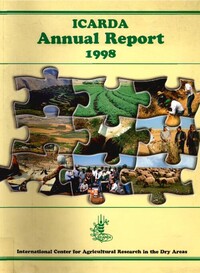ICARDA Annual Report 1998

Authors:
Cooperation, sharing expertise and technology, partnerships, and access to information formed the foundation of ICARDA's achievements during a year marked by strategic realignments and a forward-looking vision, bringing a new sense of optimism to its work in harmony with the global research continuum.
One of the major accomplishments was the innovative Consortium for Central Asia and the Caucasus (CAC). This initiative successfully brought together nine centers of the CGIAR for the first time, creating a collaborative program pioneered by ICARDA. The CGIAR program for CAC can be likened to a 'one-stop shop' for national agricultural research systems (NARS) in the region, allowing them to develop joint projects and benefit from the collective efforts of the centers involved in the Consortium.
The emerging republics in CAC are determined to enhance their existing research capabilities and reorient their agricultural economies to operate under free-market conditions. By 2025, populations in at least three of the five Central Asian Republics are projected to more than double, with rapid expansion expected in the others as well. Issues such as overgrazing and the encroachment of rangelands for cultivation in Kyrgyzstan, Tajikistan, Turkmenistan, and Uzbekistan exacerbate feed shortages. The Consortium aims to address these urgent needs, serving millions of people in CAC who deserve immediate support.
In support of its collaborative efforts in CAC, ICARDA established a Regional Program Office in Tashkent in 1998. This office also hosts the CGIAR Program Facilitation Unit, which facilitates communication between CAC NARS and the Consortium of CGIAR centers.
There are numerous other examples of innovative cooperation. For instance, the Agrobiodiversity Project, involving Jordan, Lebanon, Palestine, and Syria, is being coordinated from ICARDA headquarters and is funded by the United Nations Development Programme's Global Environment Facility (GEF). This project aims for in situ conservation of landraces and wild relatives of important crop species, showcasing cooperation between international and regional centers, donors, and national programs.
The Medium-Term Plan for 1998-2000, implemented during the year, guided the progress of ICARDA's realigned work program, which includes several strategic initiatives to respond to the needs of NARS in a changing environment. As water conservation is central to the overall research program, efforts in this area have been strengthened and more closely integrated with crop improvement and natural resource management.
One specific area of focus is soil management, where the application of remote sensing techniques in combination with geographic information systems (GIS) is beginning to show how significant savings in manpower and time can be achieved in planning and executing water harvesting schemes. Satellite imagery is being utilized to develop digital soil maps for effective natural resource management. Additionally, there is an increased emphasis on training national partners in these new tools through specialized training courses held both at headquarters and in countries within the region. The Center also promotes the development and use of computer expert systems.
